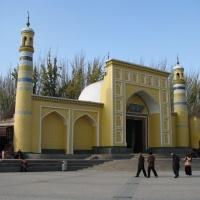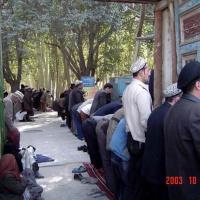The Id Kah mosque ( or aiti gaer in Chinese and means Square of festival in uyghur) is regarded as the biggest mosque in China. This typical Uyghur structure, located in the center of Kashgar, has a history of more than five hundred years. Every Friday, it houses nearly 10,000 worshippers and may accommodate up to 20,000. About 100,000 worshippers attend religious service at the same time.
The mosque was built by Saqsiz Mirza in ca. 1442 although it incorporated older structures dating back to 996. It was extended and renovated several times but kept the style, size, painting, and finally reached its present size.



Covering an area of 16,800 square meters, the Mosque is 140 meters long from south to north and 120 meters from east to west. It consists of the Doctrine-teaching Hall, the Hall of Prayer, the gate tower, a pond and some other auxiliary structures. Yellow bricks with pointed joint set distinct lines for the gate of the mosque; on both side of the gate are 18-meter high round brick columns half embedded in the wall.
On the top of the columns stands a tower where the imam would call on the Muslims to attend service at dawn every day in the mosque; the hall's ceiling, decorated with fine wooden carvings and colorful flower-and-plant painting patterns, is suppourted by one hundred carved wooden columns. A throne seat for deep shrime is placed in the middle part of the wall in the main hall. In a tree-graced courtyard outside the hall, there is a pond where place many pottery nearby for prayers to wash their hands, faces, feet, and more before attending the service.



During service, the First Maola stands in the shrine to lead the prayer. First Maola conducts "Wa'z," standing on the steps of the throne. After entering the main hall, the followers would seat themselves facing to Mecca inside and out, in proper lines. And on Fridays or Lesser Bairam and Corban such kind of biggest Islam festivals, the well-dressed Uygur people gather on the square in front of the mosque for celebration.
